Military attack leaves Myanmar’s displaced civilians with ‘no safe place’
Dozens were killed last week when the military bombed a camp for people displaced by decades of conflict.
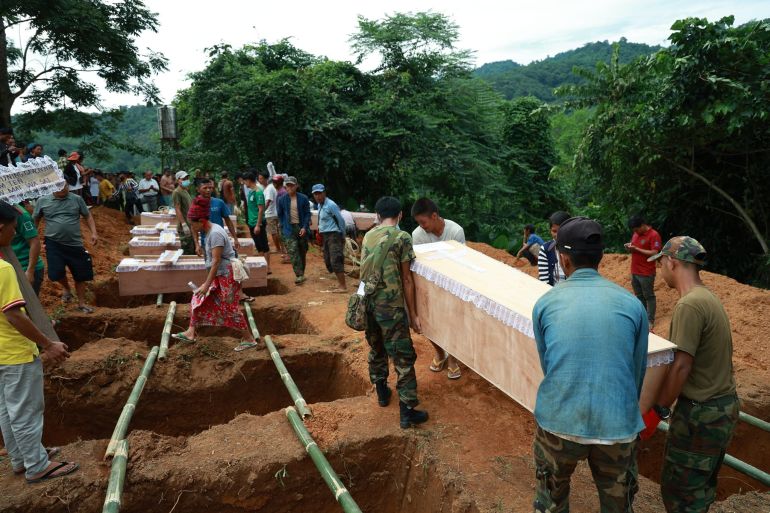
On the night of October 9, Seng Mai was awoken by a deafening explosion that tore apart her shelter in Mung Lai Hkyet, a camp for conflict-displaced people in northern Myanmar’s Kachin State.
“The sound was so loud that I wondered whether I had even survived,” the 21-year-old told Al Jazeera.
Keep reading
list of 4 itemsUK, Canada, Taiwan criticise Myanmar as generals unleash ‘corrective purge’
‘Baby steps’ for ASEAN as it wraps up first-ever joint military drills
Concerns raised over Myanmar’s ailing Aung San Suu Kyi
As rounds of mortar fire thundered from the direction of a nearby military post, she crawled into a makeshift trench.
“A grandmother was crying and shouting for help. My mother was running barefoot,” she said. “Children were also running in the dark, struggling to reach a safe place.”
By the time the bombardment was over, 28 civilians including 12 children had been killed and dozens of shelters as well as a kindergarten and church were destroyed. Rights groups have blamed the military, which seized power from the elected government of Aung San Suu Kyi in February 2021 and has so far denied responsibility for the attack.
It has an extensive record of targeting civilians and civilian areas, however, and its actions have only become “increasingly brazen” since the coup, according to a United Nations-appointed investigative mechanism. In August, the mechanism announced that it had found “compelling evidence” that the military had committed “more frequent and audacious war crimes and crimes against humanity”.
Bolstering this claim, a report published by the UN’s human rights office last month found that the military had killed at least 3,800 civilians, destroyed nearly 75,000 civilian properties and conducted nearly 1,000 air strikes in the more than two and a half years since the coup.
“Emboldened by confidence in impunity, military actions have grown in intensity and brutality,” said the report. “A seemingly endless spiral of military violence has engulfed all aspects of life in Myanmar.”
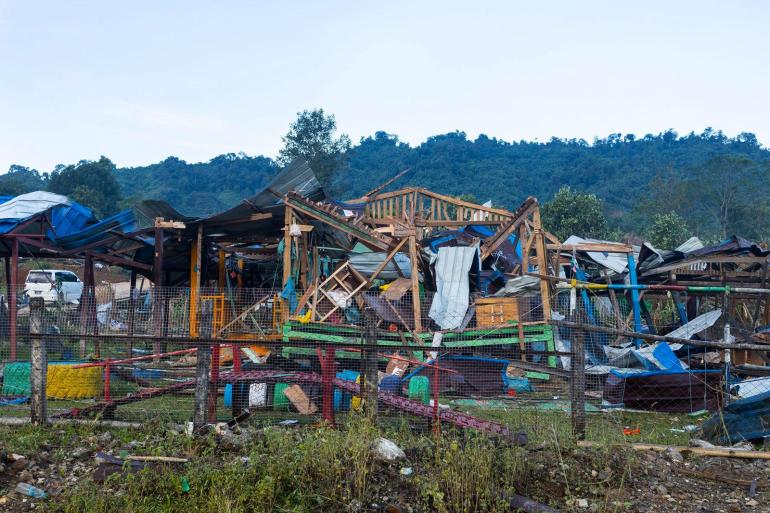
The recent attack on Mung Lai Hkyet targeted civilians displaced by war since 2011.
Several Kachin internally displaced youth, three of whom witnessed the Mung Lai Hkyet attack, told Al Jazeera the incident had left them traumatised and afraid. It also reinforced their sense that they had nowhere safe to run.
“I want to sleep at night but I can’t because I keep recalling the attack. I feel fearful and anxious about what might happen, while also recalling the terrible and tragic experiences that I’ve been through,” said Seng Mai, who has lived in Mung Lai Hkyet since 2011. “Since I became an IDP [internally displaced person], there have been many long and sleepless nights.”
Al Jazeera has given Seng Mai and others interviewed pseudonyms due to the risk of military retaliation.
‘No safe place’
Like many ethnic minorities in Myanmar, Kachin people were targets of the military’s human rights abuses long before the coup. The Kachin Independence Organisation (KIO), one of more than a dozen ethnic armed groups along the country’s borders, began its struggle for autonomy in 1961 and ever since, the military has attempted to cut its access to food, funds, intelligence and recruits in a strategy known as “four cuts.”
The approach, which specifically targets civilians, has only added fuel to the Kachin resistance, which entered a new phase with the collapse of a 17-year-long ceasefire in 2011. The fighting that followed displaced some 100,000 people, most of whom fled to camps. With the military criminalising affiliation with or support to the KIO under its Unlawful Associations Act, more than a third took refuge in KIO territory along Myanmar’s eastern border with China.
Htu Raw, who is using a pseudonym, recalled hearing the fighting break out from the state capital of Myitkyina, where she was boarding at the time to attend high school. Her family soon fled their village but she only found out two years later when she finished school and her mother came to pick her up.
“I noticed that the journey back wasn’t the same,” Htu Raw said. “I asked her where we were going, and she replied, ‘We have become IDPs now and we’re going back to the camp’.” Known as Woi Chyai, it is next to Mung Lai Hkyet and about 5km (3.1 miles) north of the KIO’s headquarters in Laiza.
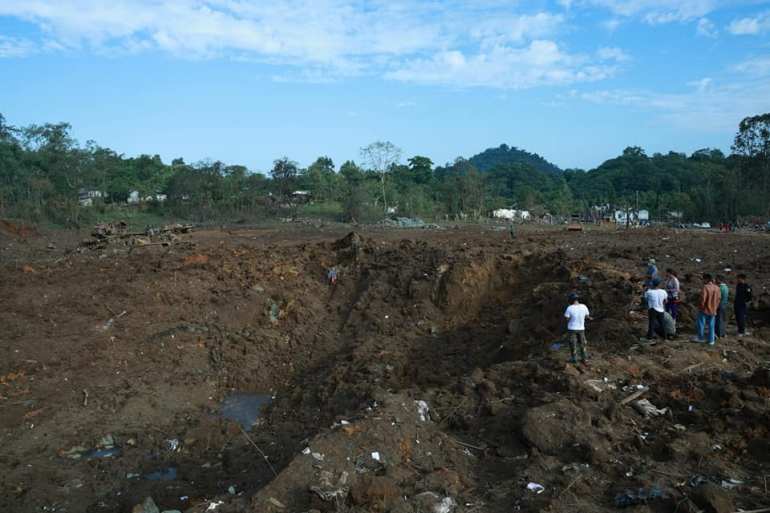
It was only a few years before fighting broke out again, prompting the camps’ residents to dig trenches where they could hide. “There were many times when we had to dig trenches and run into them when we heard the sound of planes,” said Htu Raw.
In 2019, the Aung San Suu Kyi-led civilian government began discussions with Kachin civil society about the return of displaced people to their villages as part of a broader effort to close IDP camps across the country. The initiative, however, was largely rejected by Kachin IDPs themselves due to the lack of a ceasefire between the KIO and the military, or any security guarantee for those who returned.
Still, many realised that the camps could provide them with little protection.
“Since the war resumed in 2011, the entire Laiza area hasn’t been a safe place for us to stay but we don’t have other safe places to go,” said Ah Hpung, a youth leader in Woi Chyai camp.
Traumatised people
After the coup, Kachin IDPs became even more vulnerable as security conditions deteriorated across the country. Within months, the military had killed hundreds of nonviolent protesters, provoking widespread armed resistance to its rule. The KIO has been active in providing training and weapons to newer resistance groups, while also clashing regularly with military forces.
In recent months, the fighting has increasingly neared Laiza, and although the residents of Mung Lai Hkyet had been on alert, the attack on October 9 came without warning. “Normally, we hear artillery shelling and jets flying, and we run and hide in the trenches for a moment, but in this case, we didn’t hear any planes,” said Seng Mai.
According to Ah Hpung, the attack has instilled a new level of fear among the displaced. “Since the war resumed, bombs have regularly fallen near us, but we felt we could hide in trenches during those times,” he said. “Now, those who were affected during the recent attack don’t dare to go back. We always feel unsafe in our homeland.”
He and others also described a community deeply traumatised by the incident. “Some children lost their mothers. They didn’t speak at all and just stared,” said Ah Hpung. “Some of the children who heard the sound of the bomb and witnessed the scale of the damage are losing their minds.”
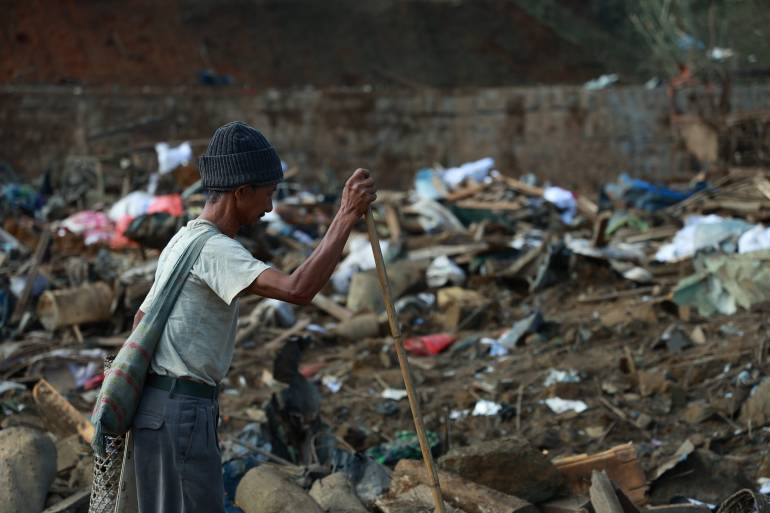
Htu Raw, who hid in a bunker in Woi Chyai camp during the attack and then rushed to help the wounded, has been unable to sleep. “When I hear the sound of a falling object, I immediately think it could be a bomb,” she said. “I’m even scared when darkness falls.”
Having lost their homes and belongings, those who survived are also likely to face significant financial hardships, exacerbating the difficulties they already faced due to the pandemic and coup. “There are many livelihood difficulties in every IDP family,” said Ah Ngwar Mee, whose nine family members survived the attack. “Because we stay in camps where we don’t own the land, it’s difficult even to garden.”
According to Htu Raw, who set aside her studies when she was 19 to work, many young people were already struggling just to attend school.“Many IDP youth want to continue their education. Some are very passionate about becoming educated but because their families are not able to support them, they have to let go of their dreams,” she said.
Ah Hpung fears that the Mung Lai Hkyet attack is likely to put students’ educational goals back even further. “Now, the youth feel hopeless and depressed about the future,” he said.
Hatred deepens
In addition to the hardships inflicted by the attack, it has only deepened the survivors’ hatred of the military. “This should be remembered as long as we live and we should pass it down to the next generation,” said Ah Hpung. “It shows the brutality of the Burmese [military] and that we should never ally or join with them.”
For many Kachin people, the attack also feeds into a sense of persecution that has only increased since the coup, especially after the military bombed a music concert near the jade mining town of Hpakant last October, leaving dozens of people dead. “They are intentionally killing our people and insulting us,” said Sut Seng Htoi, a prominent Kachin activist who was displaced in 2017. “They are trying to show that they can kill us anywhere.”
She told Al Jazeera that she would like to see Kachin people in Myanmar and around the world double down in their efforts to resist military rule and promote the development of strong and healthy Kachin institutions. “We, Kachin people, need to refocus on our unity and aspirations,” she said. “The feeling of loving our people is not enough; there must be action.”
In the week since the attack, Kachins and other Myanmar nationals around the world have worked to raise international awareness about the incident and advocate for a stronger response, including sanctions on aviation fuel which the military uses to bomb civilians. In Chiang Mai, Thailand, a group of activists held a theatrical re-enactment of the incident, and in Bangkok, a group of protesters stood in front of the United Nations office with signs calling on the organisation to “end its circle of failures in Myanmar”.
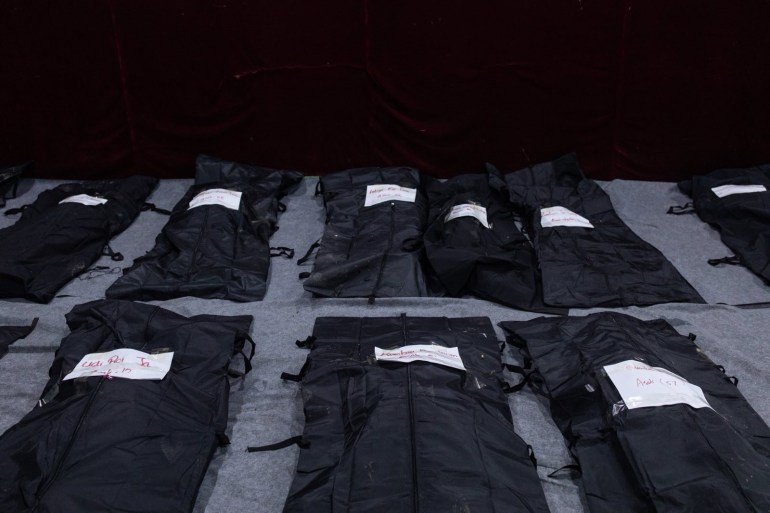
Others are raising funds, including a group of Kachin students and migrant workers in Tel Aviv, Israel who have pooled their money to send to the Mung Lai Hkyet survivors even as they hide in bunkers themselves.
Sarah Nu, a Kachin youth who has been living in Tel Aviv since 2018, said she would like to see Western countries and aid organisations offer Myanmar’s democracy movement and the Kachin struggle for self-determination the kind of attention and support that they have shown to Israel.
“Israel is already a developed nation and the United States and Western countries have supported it well. Regarding Kachin state and Kachin people, there isn’t much support,” she said. “There’s a huge difference when it comes to assisting the people.”
Back in the camp, Ah Hpung called on Kachins and others around the world to keep their attention on the crisis in Myanmar, including by promoting a better future for internally displaced youth. “Whenever there is war, we, the youth, have to suffer from it,” he said. “We need to support the youth who are supporting our people.”